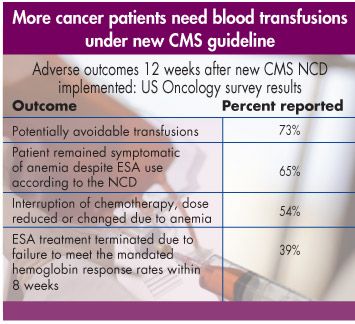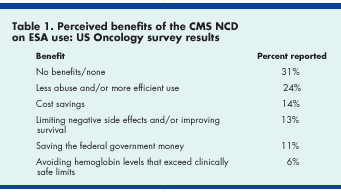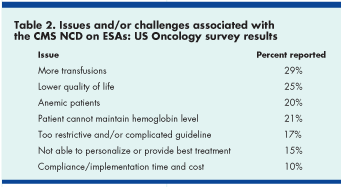Less ESA use, more transfusions
A recent national survey found a striking increase in adverse events among Medicare cancer patients directly related to CMS’ national coverage decision on the use of erythropoiesis-stimulating agents.

A recent national survey found a striking increase in adverse events among Medicare cancer patients directly related to CMS’ national coverage decision on the use of erythropoiesis-stimulating agents (see Table).
The policy allows ESAs to be initiated only when hemoglobin falls below 10 g/dL, although the products’ labels allow ESA use to maintain hemoglobin between 10 and 12 g/dL.

“This survey clearly shows that oncologists recognize that the NCD hampers their ability to deliver a full range of quality care for their Medicare patients,” Peter Ellis, MD, director, Medical Oncology Network for the UPMC Cancer Centers, Pittsburgh, said in an interview with Oncology News International.
The survey, sponsored by US Oncology, appears to confirm an outcome that had concerned many in the oncology community when the CMS policy was announced, namely, that the stringent guidelines could impede delivery of chemotherapy-related symptom care. But despite lobbying by cancer organizations, CMS refused to modify the policy, claiming the NCD guidelines set scientifically proven hemoglobin thresholds designed solely to obviate anemia-induced blood transfusions in cancer patients.

Ironically, the survey’s primary finding was a rise in potentially avoidable blood transfusions (Table).
Although there have been growing anecdotal accounts of adverse patient events resulting from the NCD, the leadership at US Oncology felt it was important to quantify the real-life clinical effects of the policy.
“We knew of adverse events related to the NCD within our network, but the survey data confirmed that practices across the country are having similar ESA-related issues,” Dan Cohen, senior vice president of government relations and public policy for US Oncology, told ONI.
Community oncologists and hematologists were surveyed to determine how the NCD affected their Medicare patients, treatment protocols, and community practices. To ensure the results were representative of the national oncology community, the survey limited the number of US Oncology-affiliated oncologists to less than 20%.
Of the 307 respondents, 91% reported adverse patient events in the 12-week period following implementation of the NCD. On average, the number of patients requiring potentially avoidable transfusions accounted for approximately 17% of their Medicare patients in the 12-week period preceding the survey. However, 9% said that the NCD was creating an avoidable need for transfusions in 50% of their Medicare patients.
Cost over care
According to Dr. Ellis, the NCD has created a clinical quandary among providers. It covers initial use of ESAs for up to 4 weeks when hemoglobin falls below 10 g/dL. After that period, additional claims for administration of ESAs are covered if a subsequent hemoglobin level is less than 10 g/dL.
“I can prescribe an ESA when the hemoglobin is 9, but as soon as it rises to 10, I have to stop. When the patient’s level drops back to 8, they need to be transfused,” Dr. Ellis said.
He explained that the NCD makes it difficult to use ESAs according to FDA labeling.
“The policy prevents us from maintaining patients’ hemoglobin levels between 10 and 12 g/dL. In essence, because of the way the NCD is written, you never are able to keep a patient’s hemoglobin up,” he said.
Dr. Ellis supports the joint resolution by the House and Senate to place a moratorium on the NCD until the effects of the policy can be fully studied. He stressed that the CMS review process needs to be transparent and should include members of the oncology community.
“We would love to address the credible patient safety issues that have been raised, as long as government policy doesn’t inhibit our ability to care for our patients,” Dr. Ellis said.

Moreover, he said that the US Oncology survey clearly showed that most of the physicians who participated view the NCD as a cost-saving tool for CMS, rather than a policy that provides benefit to patients (see Table 1).
“Naturally, medical providers are concerned with skyrocketing healthcare costs, but let’s honestly address the rising costs without affecting the clinical indications of the drugs that doctors need for delivering optimum patient care,” Dr. Ellis said.
NCD usurps physician authority
Physicians in the US Oncology survey also voiced a strong consensus (73%) that the current NCD guideline negatively impacts their ability to deliver quality care. Equally significant, 43% of the respondents said that under the NCD-mandated ESA guideline, they found it necessary to reduce or modify chemotherapy regimens for 30% of their Medicare patients.
“This survey provides important supportive evidence that the NCD is creating a two-tier system in which Medicare patients are not receiving the same quality of care as non-Medicare patients,” said Roy Beveridge, MD, a practicing oncologist in Fairfax, Virginia.
In an interview with ONI, Dr. Beveridge said the central issue is that under the NCD, oncologists are not able to use ESAs in a clinically meaningful way.
“When patients are on chemotherapy, their blood counts can drop dramatically at different times within the 3- or 4-week cycle, but the NCD only addresses how you treat patients in a steady state who aren’t having any of the normal perturbations associated with cancer treatment,” Dr. Beveridge said.
Responding to CMS’ position that ESAs have not been proven beneficial in treating quality-of-life symptoms such as anemia-induced fatigue, Dr. Beveridge said, “I’ve treated patients before the era of growth factors, and, without question, the quality of life of patients on ESAs is improved.”

Table 2 shows the concerns about the CMS policy expressed by respondents to the US Oncology survey.
On the heels of the US Oncology survey, two analyses of ESA-treated cancer patients were released at the recent Community Oncology Conference in Washington, DC. For the studies, real-world data on patients in 48 US oncology clinics were analyzed from the Dosing and Outcomes Study of Erythropoiesis-Stimulating Therapies (DOSE) registry.
Both analyses reported that patients had a significantly lower proportional need for blood transfusions when ESAs were initiated at hemoglobin levels between 10 and 11 g/dL, compared with patients having hemoglobin levels less than 10 g/dL prior to initiation of ESAs.
In an interview from the DC conference, Lee S. Schwartzberg, MD, of The West Clinic, Memphis, told ONI, “The fact that we’re seeing these survey results doesn’t surprise me. During the public comment period, more than 98% of ESA experts predicted the NCD would result in the rise in avoidable transfusions we’re now beginning to see.”
According to Dr. Schwartzberg, the NCD influence is beginning to affect the payer community, which historically has used Medicare as a template for their reimbursement policies.
“I’m hearing stories from around the country that many private payers are changing their ESA policies to adopt certain coverage features of the NCD,” Dr. Schwartzberg said. “In my own region, we’ve seen a tendency from Blue Cross/Blue Shield to require pre-certification for every patient starting an ESA.”
A growing number of payers are requiring additional laboratory values that are not part of the NCD, some of which, in Dr. Schwartzberg’s opinion, are not supported by clinical evidence.
Moreover, the net effect of mandating pre-certification using a variety of lab values puts undue burden on both the patient and the practice.
How can it save money?
“This policy actually generates more office visits for patients. I can’t see how it’s going to save money for third-party payers,” Dr. Schwartzberg said.
When government attempts to balance the costs and benefits of healthcare, it is important to understand the intended and unintended consequences. The evidence from the US Oncology survey and the two analyses presented in Washington bolster growing anecdotal reports signaling that the NCD requires more clarity about how it is affecting the cancer care of Medicare patients.
Dr. Schwartzberg stressed that CMS needs to conduct a transparent scientific review of the evidence, and “leaders of the oncology community need to be at the table.”
Newsletter
Stay up to date on recent advances in the multidisciplinary approach to cancer.